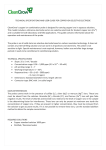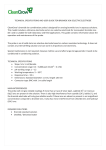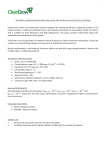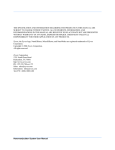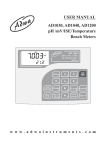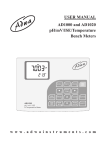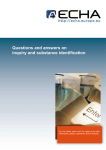Download TECHNICAL SPECIFICATIONS AND USER GUIDE
Transcript
TECHNICAL SPECIFICATIONS AND USER GUIDE FOR LITHIUM ION SELECTIVE ELECTRODE CleanGrow’s lithium ion combination probe is designed for sensing lithium ions in aqueous solutions. This model includes a reference electrode and an ion selective electrode for monovalent lithium ions (Li+) and is suitable for both laboratory and field applications. This guide contains information about the operation and maintenance of the probe. The probe is an all solid state ion selective electrode based on carbon nanotube technology. It does not contain any internal filling solution and can work in all positions and stored dry. The probe is not sensitive to light. Special maintenance is not required, however, before use and after large storage periods it needs to be conditioned in conditioning solution. TECHNICAL SPECIFICATIONS Slope: 56 ± 5 mV / decade Concentration range: 0.1 – 5,000 ppm pH working range: 2 – 12 Working temperature: 5 – 50°C Response time: < 20 s Dimensions: Standard diameter 10 mm, length 120 mm Connector type: BNC with 1 m cable length MAIN INTERFERENCES These selectivity coefficients were determined using the Separate Solution Method according to IUPAC recommendation. log K (Li+/K+) = -3.0 log K (Li+/Na+) = -3.1 log K (Li+/H+) = -3.0 REQUIRED SOLUTIONS Lithium standard solution 1000 ppm Distilled / Deionised water BEFORE USE • Remove the protective cap from the tip of the probe. • Condition the probe with a lithium solution of 1000 ppm for at least 10 minutes. MAINTENANCE AND STORAGE • Store in a cool, dry place. • Store and transport below 50°C • When finished measurements replace the protective cap of the probe. Do not leave the probe uncapped for long periods of time. • Do not hit or scrape the tip of the probe. MEASURING HINTS • All samples and standards should be at the same temperature for precise measurement. • Calibration and measurements times must be similar. • Always rinse the probe with deionised water and dry between measurements. Use a clean, dry tissue to prevent cross-contamination and shake the probe gently to remove remaining water drops. • Shake the probe slightly when immersed in solution to avoid air bubbles enclosing on the tip of the probe. There are two methods of determining the Li concentration as follows: A. LITHIUM ION DETERMINATION USING DIRECT MEASUREMENT This method may be suitable if it achieves the desired accuracy for the intended application. 1) By serial dilution, prepare 0.01, 0.1, 1 and 10 ppm Li standards. Immerse the electrode in 0.01 ppm standard solution for one minute. Dry the outside of the probe and give the probe a quick shake to avoid cross-contamination between solutions. 2) Calibrate the electrode with the remaining three standards from low to high concentration by following the step-by-step instructions using CleanGrow’s meter. Ensure the probe is dried between solutions. 3) Rinse the probe with deionised water and blot dry. Take a sample reading. This method is suitable for a limited pH range ideally between pH 4–6 where the change in mV is not high. It is strongly recommended to regenerate the electrode by immersing it in 1000 ppm lithium before being stored. This will help to prolong the electrode’s life and will also decontaminate the membrane. Additional Accuracy for direct measurement of Li ion Instead of preparing standards using deionised water, additional accuracy would be obtained by using a background matrix/formulae similar to the test sample. This will improve accuracy of measurement and also reduce drift effects. This method will take into account the effect of any chelating agents and therefore allow for accurate measurement of free lithium ions. B. LITHIUM ION DETERMINATION BY STANDARD ADDITION (Using excel file). This procedure allows the determination of lithium ions in complex matrices or when high, perhaps unknown, interferences are present. It is likely to give more accurate data and is suitable when mimicking the matrix of the sample is not possible and when variation in pH is an issue. The disadvantages of this method are the requirement of precise laboratory material and contamination of the original sample. It requires manual or magnetic stirring. Follow these steps: 1) Immerse the probe tip in 50 ml of the sample. When the reading has stabilised (after approximately 1 min), record the mV reading. 2) Add 50 µl of 1000 ppm Li standard solution to the sample to increase the lithium concentration. Ensure the solution is mixed. Record the mV reading after stabilisation. Finally rinse the probe with deionised water, dry, and replace the protective cap. 3) Calculate the concentration using the excel document. Please take care to fill in the correct units in all the cells. It is strongly recommended to regenerate the electrodes by immersing in 1000 ppm lithium before being stored. This will help to prolong the electrode’s life and will also decontaminate the membrane. CleanGrow Ltd., Unit 4, Euro Business Park, Little Island, Co. Cork, Ireland. Tel: +353-21-4232000 E-mail: [email protected]




